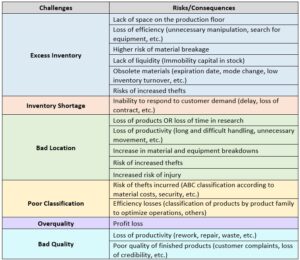Managing raw materials is an important operation because these materials can monopolize a good part of the capital invested by a company.
In fact, according to Statistics Canada, manufacturing costs related to materials and supplies were around 60% of the revenues of manufacturing companies in 2019.
This corresponds to 432 billion dollars spent by these companies on materials and supplies out of 750 billion in total revenues.
So there you have it, a good reason to manage and budget your raw materials properly!
In this article, raw material management is discussed. Classification, storage, and stock rotation are covered.
For more information on commodity budgets, please see the following article:
https://collectionfinance.com/en/raw-materials-budget/
This one offers a Free Tool to establish your raw material budgets!
What is a Raw Material?
A raw material is a material transformed for the purpose of manufacturing a finished or intermediate product. Raw materials also include the energy needed to produce a processed product.
The finished product of one company can become the raw material of another. These pre-processed materials are said to be intermediate. Therefore, raw materials are the products initially used by a manufacturing process to obtain a new one.
For example, a Mine extracts iron ores, then sells them to a steel company which first transforms these ores into iron bars (their “finished product”).
Next, the steel company sells its iron bars to a sheet metal manufacturing company. This second company uses iron bars as a raw material to transform them into sheets of steel.
The iron bars are therefore a raw material for the latter company and the steel sheets are the finished product.
This process can continue in this way until a non-transformable finished product is obtained. That is to say, it has its final form.
Managing Raw Materials: Issues and Consequences of Poor Management
To optimize the management of raw materials, you must first know the issues related to them.
To summarize these issues, here is a chart outlining the risks and consequences of mismanaging raw materials:
Managing raw materials is an important element for all manufacturing companies. Poor management results in lost revenue, and profits and can even bankrupt companies.
To obtain the best results and maximize your income, you have to take the time to manage your raw materials in an optimal way.
Managing Raw Materials: How to do it Efficiently?
Now that we know the issues related to poor management of raw materials, how can we avoid them?
Let’s take the issues presented in the table above and see some ways to make sure to avoid the related consequences.
Inventory
To ensure that inventory levels are optimized, sales forecasts (from which the raw material forecasts necessary for manufacturing derive) and the establishment of min-max can be good alternatives.
This will allow you to not run out of materials, without however storing too many of them. In addition, the min-max method makes it possible to maintain a safe stock ensuring that there is no shortage of stocks according to restocking times.
In addition, several ERP or MRP software can automate its operations.
Another interesting tool to maintain healthy inventory management is Kanban. This method makes it possible to maintain a satisfactory level of inventory and work in progress at each workstation.
Finally, location, the next point discussed, facilitates inventory management. By efficiently arranging its warehouses and inventory spaces, inventory management is facilitated.
Localization
The location of stocks or the layout of the inventory system is one of the pillars of sound management of raw materials.
This optimizes productivity by minimizing travel, handling, searching for information, waste, etc.
Also, it is easier to balance your inventories with your computer system and it allows you to easily and quickly get an idea of the inventories visually.
Localization is used to identify the locations of different products in computer or manual systems (if applicable).
To facilitate and optimize searches, a good nomenclature is essential. This will help avoid confusion and make it easy to find any of the products.
Finally, the localization of products makes it possible to establish min-max systems by location. It is an effective and easy-to-implement method.
We identify the location of raw material and when a location is empty, we replace (order) the product so as not to run out. The number of locations and the number of products per location is determined by the cost of materials and the lead time.
Classification of Raw Materials
There are several ways to categorize or classify materials or products in order to improve their management.
The classification of raw materials consists of grouping them by category or characteristic in order to improve their safety, traceability, and productivity in general.
For example, the ABC classification can be used to group raw materials according to their monetary value or they can be grouped by product family to minimize handling times.
ABC Classification
The ABC classification uses the Pareto principle (80-20 law) to classify products into three categories: A, B, and C. According to Pareto, 20% of the causes are responsible for 80% of the consequences. For example, 20% of raw materials represent 80% of a company’s total PM costs.
Products are those that require tight and precise control and monitoring. It is the 20% of raw materials that monopolizes 80% of the total costs. We, therefore, want to maximize their management to ensure their safety and avoid breakage, theft, overstocking, etc.
B products are medium-value products. They require slightly less rigid control and monitoring than A products.
Finally, category C raw materials are those of lower value. They require minimal control and monitoring so as not to explode management costs.
The ABC classification can be done by monetary value, but also by following other indicators. For example, a company could categorize its products according to their use. In this case, product A would be the 20% of products that the company uses 80% of the time.
Pareto’s law is not an exact rule, but rather a general principle. Whether it is 10-90, 20-80, 30-70, or others, the majority of the consequences of a situation are generally caused by a minimum of causes. We, therefore, want to focus our efforts on this “20%” of the cause in order to optimize our results!
Classification by product family
This type of classification categorizes the raw materials according to the families of products manufactured by the company.
This makes it possible to minimize handling times by grouping the materials necessary for the manufacture of similar products or passing through the same production equipment.
This method makes it possible to reduce travel, the search for equipment, unnecessary gestures, and handling, etc.
Quality
The quality of the raw materials used in the manufacture of products is decisive for the profitability of a company.
In the event that one buys raw materials of too high quality, one pays for something that does not bring value to the customers and for which he is not ready to pay. We, therefore, end up selling a product with a higher manufacturing cost than necessary.
When we cut too much in the quality of raw materials, we end up with productivity problems, because we increase waste, production losses, repairs, etc. Moreover, while we repair a product, we do not produce others! This translates into a loss of opportunity or production capacity.
To be optimal, we can discuss with our customers to know their criteria and to know what they are ready to pay. You have to know the added value of our product.
To ensure the conformity of a batch of raw materials, sampling methods can make it possible to ensure that batches of materials are received according to determined quality criteria.
For more information related to the most popular sampling methods, here is a link to an article that discusses this topic:
https://collectionperformance.com/en/sampling-plan-complete-guide/
Conclusion
In conclusion, managing raw materials is an important element for any manufacturing company. The costs generated by the raw materials are generally very important for the companies and therefore it becomes interesting to minimize these costs to maximize its profits.
There are several issues related to poor management of raw materials and these can have serious consequences for lax companies. The table presented above summarizes these issues and the related consequences.
Finally, there are several tools and methods to better manage and optimize the management of raw materials. Some tools are presented through the text such as the ABC classification of products, good localization, and good quality of raw materials.
Knowing that the costs of raw materials can represent a large proportion of a company’s manufacturing costs, it must be admitted that sound management is essential to remain competitive!
Reference :
Statistique Canada, 2019. Taken from https://www.ic.gc.ca/app/scr/app/cis/manufacturing-fabrication/31-33?lang=eng in December 2022.









